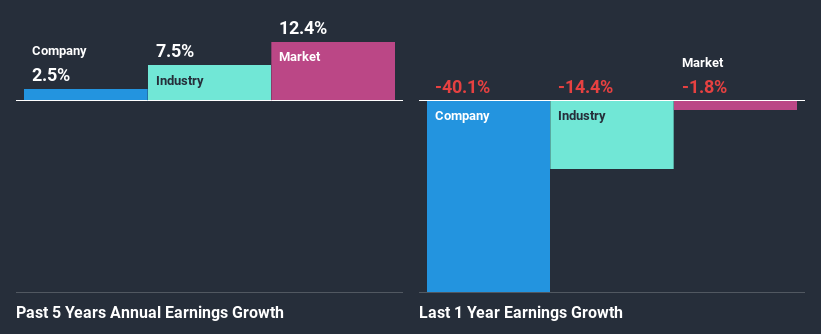- Australia
- /
- Transportation
- /
- ASX:LAU
Lindsay Australia Limited's (ASX:LAU) Dismal Stock Performance Reflects Weak Fundamentals

It is hard to get excited after looking at Lindsay Australia's (ASX:LAU) recent performance, when its stock has declined 2.9% over the past three months. To decide if this trend could continue, we decided to look at its weak fundamentals as they shape the long-term market trends. In this article, we decided to focus on Lindsay Australia's ROE.
Return on equity or ROE is an important factor to be considered by a shareholder because it tells them how effectively their capital is being reinvested. In short, ROE shows the profit each dollar generates with respect to its shareholder investments.
Check out our latest analysis for Lindsay Australia
How To Calculate Return On Equity?
Return on equity can be calculated by using the formula:
Return on Equity = Net Profit (from continuing operations) ÷ Shareholders' Equity
So, based on the above formula, the ROE for Lindsay Australia is:
5.8% = AU$5.3m ÷ AU$92m (Based on the trailing twelve months to June 2020).
The 'return' refers to a company's earnings over the last year. Another way to think of that is that for every A$1 worth of equity, the company was able to earn A$0.06 in profit.
Why Is ROE Important For Earnings Growth?
Thus far, we have learned that ROE measures how efficiently a company is generating its profits. Based on how much of its profits the company chooses to reinvest or "retain", we are then able to evaluate a company's future ability to generate profits. Assuming all else is equal, companies that have both a higher return on equity and higher profit retention are usually the ones that have a higher growth rate when compared to companies that don't have the same features.
A Side By Side comparison of Lindsay Australia's Earnings Growth And 5.8% ROE
When you first look at it, Lindsay Australia's ROE doesn't look that attractive. Yet, a closer study shows that the company's ROE is similar to the industry average of 7.0%. Having said that, Lindsay Australia has shown a meagre net income growth of 2.5% over the past five years. Remember, the company's ROE is not particularly great to begin with. Hence, this does provide some context to low earnings growth seen by the company.
Next, on comparing with the industry net income growth, we found that Lindsay Australia's reported growth was lower than the industry growth of 7.5% in the same period, which is not something we like to see.

Earnings growth is an important metric to consider when valuing a stock. What investors need to determine next is if the expected earnings growth, or the lack of it, is already built into the share price. By doing so, they will have an idea if the stock is headed into clear blue waters or if swampy waters await. One good indicator of expected earnings growth is the P/E ratio which determines the price the market is willing to pay for a stock based on its earnings prospects. So, you may want to check if Lindsay Australia is trading on a high P/E or a low P/E, relative to its industry.
Is Lindsay Australia Efficiently Re-investing Its Profits?
With a high three-year median payout ratio of 70% (or a retention ratio of 30%), most of Lindsay Australia's profits are being paid to shareholders. This definitely contributes to the low earnings growth seen by the company.
Moreover, Lindsay Australia has been paying dividends for at least ten years or more suggesting that management must have perceived that the shareholders prefer dividends over earnings growth. Upon studying the latest analysts' consensus data, we found that the company is expected to keep paying out approximately 67% of its profits over the next three years. However, Lindsay Australia's ROE is predicted to rise to 9.2% despite there being no anticipated change in its payout ratio.
Summary
On the whole, Lindsay Australia's performance is quite a big let-down. The company has seen a lack of earnings growth as a result of retaining very little profits and whatever little it does retain, is being reinvested at a very low rate of return. That being so, the latest analyst forecasts show that the company will continue to see an expansion in its earnings. To know more about the latest analysts predictions for the company, check out this visualization of analyst forecasts for the company.
When trading Lindsay Australia or any other investment, use the platform considered by many to be the Professional's Gateway to the Worlds Market, Interactive Brokers. You get the lowest-cost* trading on stocks, options, futures, forex, bonds and funds worldwide from a single integrated account. Promoted
New: AI Stock Screener & Alerts
Our new AI Stock Screener scans the market every day to uncover opportunities.
• Dividend Powerhouses (3%+ Yield)
• Undervalued Small Caps with Insider Buying
• High growth Tech and AI Companies
Or build your own from over 50 metrics.
This article by Simply Wall St is general in nature. It does not constitute a recommendation to buy or sell any stock, and does not take account of your objectives, or your financial situation. We aim to bring you long-term focused analysis driven by fundamental data. Note that our analysis may not factor in the latest price-sensitive company announcements or qualitative material. Simply Wall St has no position in any stocks mentioned.
*Interactive Brokers Rated Lowest Cost Broker by StockBrokers.com Annual Online Review 2020
Have feedback on this article? Concerned about the content? Get in touch with us directly. Alternatively, email editorial-team@simplywallst.com.
About ASX:LAU
Lindsay Australia
Provides integrated transport, logistics, and rural supply services to the food processing, food services, fresh produce, and horticulture sectors in Australia.
Very undervalued established dividend payer.
Market Insights
Community Narratives



